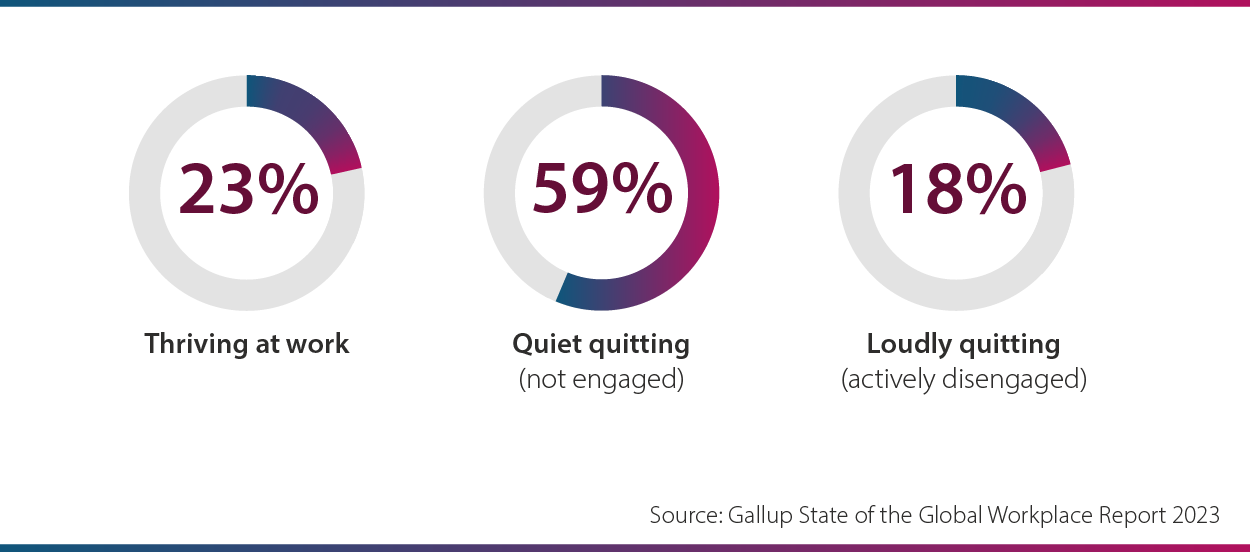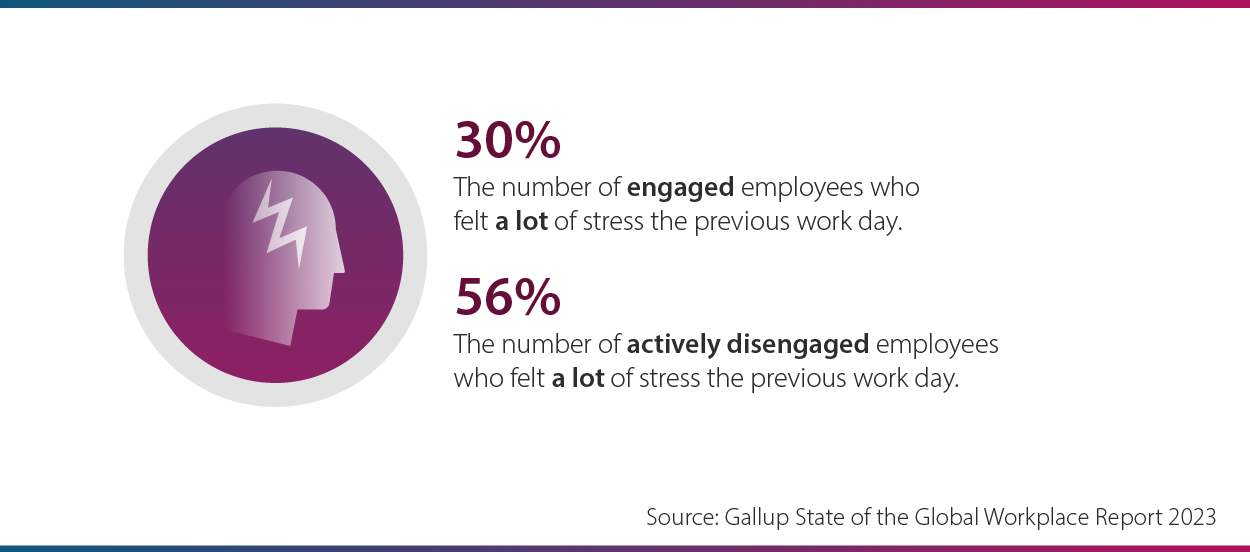The Gallup State of the Global Workplace 2023 report is here. What are the trends and challenges in the working world this year? Read on for Insights’ recap on the annual findings from the world’s largest ongoing study of the employee experience…
When we think of a thriving workplace culture, we often think of a bustling bubble of activity. Employees are driven, feel passionate about their work, take initiative, and feel connected to the company’s values and mission.
Unfortunately, if many of the world’s workers were asked to describe their current workplace, it would starkly contrast this organizational utopia.
This year, Gallup estimated that low engagement costs the global economy $8.8 trillion. That’s a whopping 9% of global GDP, and thus, within the context of slowing economic growth, supercharging engagement within your workplace is critical.
Engagement at work is crucial from a financial standpoint and important for company culture and morale. Simon Sinek states, ‘when people are financially invested, they want a return [but] when people are emotionally invested, they want to contribute’.
How can we ensure that our people feel emotionally invested in 2023?
Gallup found a clear answer: Change the way your people are managed.
Poor management is at the crux of many corporations’ pain points. It leads to lost customers and lost profits, argues Gallup, and impacts people’s lives outside of work.
Indeed, Gallup’s research into workplace wellbeing finds that ‘having a job you hate is worse than being unemployed’. Unsurprisingly, these negative emotions may permeate other aspects of life echoing at home and impacting retention with an increased number of people quitting without the next steps lined up.
Ultimately, Gallup argues that if you’re not thriving at work, you’re unlikely to be thriving at life.
“Having a job you hate is worse than being unemployed…” – Gallup
It’s not all doom and gloom
The prognosis isn’t as dire as first impressions show.
In fact, in 2022, the global workplace experienced an engagement rebound. 2022 also saw job opportunities surge globally, in keeping with pre-pandemic historical trends on economic growth and development.
However, where there are positive trends emerging, there’s also a lot of work to do.
2022 saw global worker stress at a historic high, even as other negative emotions related to the COVID-19 pandemic subsided. Gallup argues that this high level of stress may be due to the recovery itself, as many regions of the world struggle to control high inflation and the fallout of the COVID-19 period.
Therefore, as we attempt to navigate current uncertain economic outlooks, organizational leaders must acknowledge the impact that their employee’s stress is having on productivity and performance.
Gallup argues that concentrating on these well-being concerns and improving engagement should be top priorities for the world’s business leaders who seek to make the most of the recovery.
“Leaders [can] engage their teams by giving them a sense of purpose, providing them opportunities to develop and advance, and putting them into positions where they can be successful.”- Gordon Tredgold
A deep dive into the findings…
The report highlighted that championing engagement and wellbeing initiatives within the workplace is critical, but why? Let’s explore the global trends uncovered by Gallup…
Here are our top four highlights:
- Employee engagement is at a record high
2022 saw employee engagement at a record 23% high.
As the highest recorded level since Gallup began measuring global workplace engagement in 2009, the report found that engagement had returned to its historically positive trend, recovering from the engagement decline reported in 2020. The increased engagement is brilliant news for employees who find their daily work rewarding. But there is a long way to go...
- ‘Quiet quitting’ is rife, but it’s an opportunity for growth
The report found the majority of global workers are ‘quiet quitting’ (not engaged) or ‘loudly quitting’- what Gallup refers to as ‘actively disengaged’.

Despite these pessimistic numbers, there is opportunity for improvement.
Engaged employees stay for what they give and disengaged employees, generally, stay for what they can get. As leadership directly influences workplace engagement, there is much that organizations can do to help their employees thrive at work.
Where ‘loud quitting’ can signal major risks within an organization that shouldn’t be ignored, Gallup argues that quiet quitters are your greatest opportunity for growth and change. Nearly six in ten employees are quietly quitting, yet changes to their workplace may see them become engaged.
Brad Federman says, ‘paychecks can’t buy passion.’ A claim that is undisputedly true. However, management can encourage, inspire and empower their employees; igniting passion through small changes in how employees are managed.
In the report, Gallup asked respondents, “What would you change about your workplace to make it better?”
85% of the responses were related to:
- Engagement
- Culture
- Pay and benefits
- Wellbeing- work/life balance
The solutions are there. It’s down to leaders to ensure that global employees get the support and empowerment to experience increased levels of workplace engagement.
- Nearly half of the world's employees are stressed
44% of employees surveyed said they experience high levels of daily stress, repeating the record high seen in 2021 and continuing an upward trend of elevated stress.
But why are employees so stressed?
Where the Gallup survey does not ask for specifics, there’s an array of factors that could contribute to this global trend. Work itself can be a cause of stress, but external factors like inflation or personal issues can play a critical role.
Leadership is critical to mitigate stress levels. Although external factors can’t be changed, management can prioritize reducing workplace stressors.
Gallup’s analysis found that low engagement is related to higher stress, with employees that are engaged at work reporting significantly lower levels of stress in their lives.

- It doesn't look great for retention
The report found that over half of the world’s employees expressed some level of intent to leave their job, with 51% of currently employed workers stating that they are either watching for or actively seeking a new job.
How can organizations mitigate this?
The answer isn’t surprising: Increase employee engagement
Gallup found that engaged employees require a 31% pay increase to consider jumping ship and taking a job with a different organization, whereas disengaged employees, on average, would change jobs for a 22% pay increase.
This is hammered home by the percentage of employees actively seeking a new job, with 43% of engaged employees window shopping, compared to 61% of actively disengaged.
In short, engaging employees can create a cushion, or as Gallup phrases it ‘a moat of protection’, lessening the chances of them actively seeking other opportunities.
The takeaways
The takeaway is simple: engage your employees.
When employees are engaged, organizations experience a boost in morale, increased profits, enhanced productivity and, a healthier workplace culture.
We know that engaging employees isn’t a simple feat. It’s difficult to balance so many spinning plates, but ensuring your employees feel supported, and that they find purpose in their work, is critical.
It’s time to take a look at how your people are managed. Empowering leadership to support their teams is the starting point for combating these global workplace challenges.
Leadership plays a crucial role here, but it’s a two-way street…
The solution: Activating awareness for an engaged workforce
At Insights, it’s no secret that we champion the power of awareness, and the success this can bring to your teams and organizations.
Awareness helps employees play to their strengths and understand their preferences, and it encourages an appreciation for others’ preferences. Introducing the language of color to your organization creates a shared sense of understanding that can aid in an increase in employee engagement and connection with team members.
It is the role of leadership and the wider organization to collectively create and nurture an environment that supports workplace engagement.
Through increased awareness, leaders can adjust their management style to become the effective leaders their people need, and employees can understand their own engagement needs and take responsibility to ensure they are met.
Better leadership starts with more self-insight.
Want to know how your teams tick? Insights are happy to help
Read the full Gallup State of the Global Workplace Report here.

